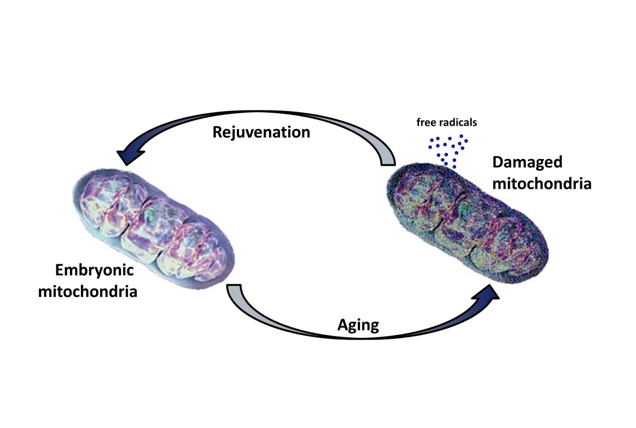Singapore scientists discover rejuvenation factors

Mitochondria during cellular aging. Copyright: A*STAR
Scientists from A*STAR’s Genome Institute of Singapore (GIS) have discovered metabolic rejuvenation factors in eggs. This critical finding furthers our understanding of how cellular metabolism changes during aging, and during rejuvenation after egg fertilisation.
When a sperm fertilises an egg to create a baby, two adult cells combine to form a new embryo. A similar process of combining an egg’s cytoplasm with an adult cell nucleus led to the cloning of Dolly the sheep. However, the metabolic factors underlying this fascinating process had remained unclear.
A new study from GIS suggests that old mitochondria – the oxygen-consuming metabolic engines in cells – are roadblocks to cellular rejuvenation. By tuning up a gene called Tcl1, which is highly abundant in eggs, researchers were able to suppress old mitochondria to enhance a process known as somatic reprogramming, which turn adult cells into embryonic-like stem cells.
GIS researchers found that Tcl1 does its job by suppressing mitochondrial polynucleotide phosphorylase, thereby inhibiting mitochondrial growth and metabolism.
Findings from the study were published in the scientific journal Cell Reports.
Stem cell researchers had known that egg (or oocyte) cytoplasm contains some special unknown factors that can reprogramme adult cells into embryonic-like stem cells, either during egg-sperm fertilisation or during artificial cloning procedures like those that created Dolly the sheep. While the Nobel Prize winner Dr Shinya Yamanaka had invented a technology called induced pluripotent stem cell (iPSC) reprogramming to replace the ethically controversial oocyte-based reprogramming technique, oocyte-based reprogramming was still deemed superior in complete cellular reprogramming efficiency.
To address this shortfall, the GIS team led by Dr Khaw Swea-Ling, Dr Lim Bing and Dr Ng Shyh-Chang combined oocyte factors with the iPSC reprogramming system. Their bioinformatics-driven screening efforts[1] led to two genes: Tcl1 and its cousin Tcl1b1. After a deeper investigation, the team found that the Tcl1 genes were acting via the mitochondrial enzyme, PnPase.
“We were quite surprised, because nobody would have thought that the key to the oocyte’s reprogramming powers would be a mitochondrial enzyme. The stem cell field’s conventional wisdom suggests that it should have been some other signalling genes instead,” said corresponding author of the research, Dr Ng Shyh-Chang.
Tcl1 is a cytoplasmic protein that binds to the mitochondrial enzyme PnPase. By locking PnPase in the cytoplasm, Tcl1 prevents PnPase from entering mitochondria, thereby suppressing its ability to promote mitochondrial growth and metabolism. Thus, an increase in Tcl1 suppresses old mitochondria’s growth and metabolism in adult cells, to enhance the somatic reprogramming of adult cells into embryonic-like stem cells.
Cracking the mystery of reprogramming factors in oocytes is an important milestone. These new insights could boost efficacy of the alternative, non-oocyte-based iPSC techniques for stem cell banking, organ and tissue regeneration, as well as further our understanding of how cellular metabolism rejuvenates after egg-sperm fertilisation. This could help address both the aging and the fertility problems of modern societies.
GIS Executive Director Prof Ng Huck Hui said, “This is an exciting step forward in the study of cellular aging. Although accumulated defects in mitochondrial metabolism were known to cause cellular aging, no solutions were available. Shyh-Chang’s team has uncovered a molecular pathway to solve this problem”.
[1] While the researchers attempted to deconstruct the mechanisms of oocyte-based reprogramming, no human oocytes or embryos were used or destroyed in the process as the screening effort was bioinformatics database-driven.
Associated links
Original press release from A*STAR
Media Contact
More Information:
http://www.researchsea.comAll latest news from the category: Life Sciences and Chemistry
Articles and reports from the Life Sciences and chemistry area deal with applied and basic research into modern biology, chemistry and human medicine.
Valuable information can be found on a range of life sciences fields including bacteriology, biochemistry, bionics, bioinformatics, biophysics, biotechnology, genetics, geobotany, human biology, marine biology, microbiology, molecular biology, cellular biology, zoology, bioinorganic chemistry, microchemistry and environmental chemistry.
Newest articles

A new puzzle piece for string theory research
Dr. Ksenia Fedosova from the Cluster of Excellence Mathematics Münster, along with an international research team, has proven a conjecture in string theory that physicists had proposed regarding certain equations….

Climate change can cause stress in herring larvae
The occurrence of multiple stressors undermines the acclimatisation strategies of juvenile herring: If larvae are exposed to several stress factors at the same time, their ability to respond to these…

Making high-yielding rice affordable and sustainable
Plant biologists show how two genes work together to trigger embryo formation in rice. Rice is a staple food crop for more than half the world’s population, but most farmers…



